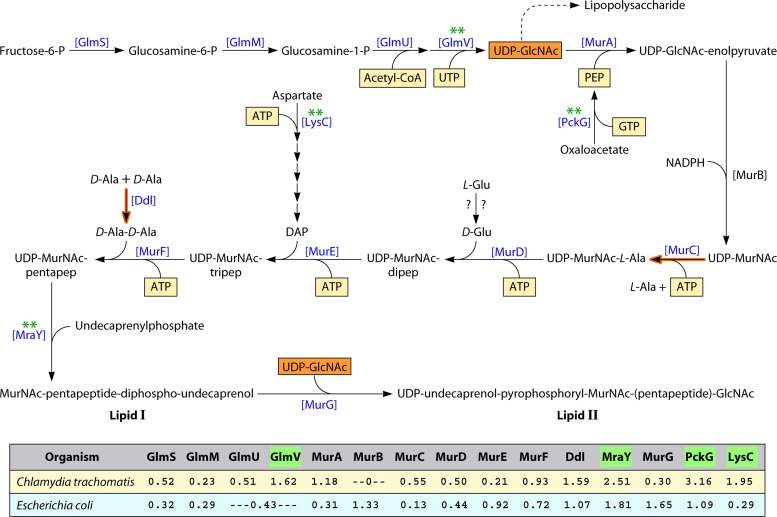Fig 7.
The lipid II pathway in Chlamydiaceae. The pathway from fructose-6-P to UDP-GlcNAc branches divergently to feed the lipopolysaccharide pathway and the lipid II pathway. The lipid II pathway is synonymous with the peptidoglycan pathway prior to the various cross-linking reactions, and the lipid II pathway is also required for cell division. The genes encoding MurC and Ddl (indicated with red arrows) are fused in the Chlamydiaceae, and the Trp contents of the two domains are shown separately in the lower table for comparison with E. coli, in which the domains are not fused. Four enzymes that exhibit particularly high demand for Trp are marked with double green asterisks in the figure and highlighted green in the lower table. The sequence of reactions catalyzed by MurCDEF are similar ATP-dependent reactions that build the pentapeptide moiety of UDP-MurNAc-pentapeptide. It is presently uncertain if the d-amino acid components of the pentapeptide are possibly replaced by another amino acid, since the genes encoding the racemase enzymes have not been identified in Chlamydiaceae. The three alternative fates of UDP-GlcNAc (two in the lipid II pathway and one in the lipopolysaccharide pathway) are indicated by the use of orange highlighting. Metabolite abbreviations: UDP-GlcNAc, UDP-N-acetylglucosamine; UDP-MurNAc, UDP-N-acetylmuramic acid. In the bottom table, the ratios of the Trp contents of the various enzymes depicted to the Trp content of the C. trachomatis proteome are compared with the corresponding ratios of E. coli. Note that E. coli lacks PckG, instead utilizing a functional analog called PckA. Also, the functions of GlmU and GlmV are carried out by a single protein in E. coli, one which did not yield any bidirectional best hits with GlmU and GlmV queries of C. trachomatis (see the text).

